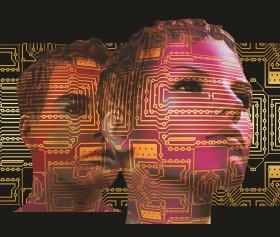

The buzz around artificial intelligence (AI) continues unabated with many companies spending vast amounts of time and money developing the various concepts of AI to enhance the products and services they have on offer. Then there are also companies that suddenly realised that AI is the buzzword of the year and immediately changed their packaging and marketing to include references to AI-enhanced solutions, without actually changing anything.

From the user side, all the marketing and hype around AI and its various components such as deep learning (DL), machine learning (ML), automation and so on can lead many to expect immediate miracles from their ‘AI-enhanced’ surveillance (and general security) products. This has created unrealistic expectations on one hand and a cynical response on the other as the amazing benefits fail to be realised in real-world settings.
So the question is, does AI deliver any benefits today? Will we see some of these ‘miracles’ happening in the future? And for the people in the industry, perhaps the question should be what the impact of AI will be on companies and the services and solutions they supply, as well as on the jobs people do.
Kai-Fu Lee is an expert in AI, having developed the world’s first speaker-independent, continuous speech recognition system as his Ph.D. thesis before taking executive roles at companies such as Microsoft and Google – among others. Although not 100 percent pertinent to the CCTV Handbook (and not 100 percent irrelevant either), his book AI Superpowers is an excellent read on AI and the different approaches taken by the two current leaders in AI – China and the USA.

Lee is also known for his worrying prediction that 40 percent of jobs will be lost to AI and robots in the future (many in the near future). ‘AI job displacement’ is the friendly term used to describe this. As AI makes an impact on the surveillance world, will this displacement also impact security technicians? Will AI make the big integrators more powerful and remove the smaller integrators and installers from the game altogether as automation gains traction?
Hi-Tech Security Solutions asked a few experts from the industry to join us for a round-table discussion on AI, its impact on the industry today and what we can expect to see happening in the real world in the near future. Looking ahead, we wanted to know what the real impact and opportunities are that AI offers to the surveillance and associated markets – such as remote monitoring, guarding, visitor management and so forth. And what benefits can customers expect to gain?

Joining us in this exploration were:
• Gerhard Furter from Iris AI.
• Clifford Gobetz from Myertal.
• MJ Oosthuizen from G4S.
• Jason McGregor from DellEMC.
• Ruaal Tromp and Janis Le Roux from Hikvision.
The growth of AI
AI is impacting every industry in some way and research shows that 75% of companies will be adding AI functionality to their products and/or processes in some way in the near future. The CCTV market, however, is not keeping up – with some notable exceptions.

This may be a question of funding or because this market has always been driven by the consumer segment where cameras used in broadcasting, for example, set the trend and the surveillance manufacturers followed in terms of lenses and resolution, etc. And more recently we are seeing more development in camera technology in the smartphone market, which gradually made and is making its way into the CCTV arena.
Other areas in which the surveillance market is behind include areas such as augmented vision, virtual reality, and behavioural analysis, again, most likely because the entertainment world has a far larger budget for R&D.
While there are some surveillance companies investing heavily in AI, the really ‘cool stuff’ is being developed by smaller companies that are pushing the boundaries – and changing the market at the same time.
Iris AI, for example, a South African ‘boutique AI development house’, has its own facial recognition technology that can work on any IP camera, even with only 1 megapixel (MP) resolution. This facial recognition solution can be used for seeing how many people are in a room, or who is in a room, or for recording time and attendance and other business functions.

It’s all about adding value to processes and operations. The company says it developed the facial recognition to “prevent us from counting people twice” when analysing crowds or attendance. The system can also determine other variables, such as ethnicity, age and gender which can also add value to various business processes.
The goal of this technology is to take advantage of what AI is good at, which is analysing behaviour. It can recognise anomalies – what is happening at any time of the day. If an anomaly occurs, the AI will recognise it and inform whoever needs to be informed to deal with the situation; it augments processes and procedures to ensure efficient operations in that situation – whether it’s traffic jams in the parking lot or safety aspects in a factory, long queues at retailers and so on.
In a security context, this will enhance guard operations by giving them insights into what is happening on a site. For example, if there is a queue of cars at the gate, the AI can recognise this, allowing management to intervene, find the cause and then augment their operations to prevent this in future.
Another area of development that is receiving a lot of attention is facial expression recognition (FER). This can, as an example, allow companies such as retailers to determine someone’s mood and extrapolate more information in terms of their propensity to make a purchase or walk out the door.
Just a sensor
And while some vendors are still marketing their cameras based on the specifications on the box, the way the world is moving has made the camera just another sensor in an Internet of Things (IoT) world – it’s a tool used to add value. And the value you add is what differentiates buying a camera as a grudge purchase because you have to do something to try and secure your premises or people, and buying a service or system that you need to enhance operations or boost the bottom line while also securing premises and people.
Cameras are becoming data generators, or intelligence generators to provide insight into customers’ environments. One of the big retailers in the US has opened stores where cameras are used to replace till points and scanners. Customers are recognised when they enter the store and then they simply take products off the shelves, put it in their bags and walk away.
Their purchases are recognised and charged automatically to their credit cards, and the system recognises if someone takes an item off the shelf and then puts it back, ensuring they don’t get charged for that. This is not a security solution, although it makes sure people don’t walk out of the store without paying, but it adds value in an AI and IoT world where the camera is simply a tool and not the focal point.
As we have mentioned before, value is the key to a sale and was what was being sold in the past when people referred to ‘solutions’ and ‘integration’ rather than products. In the AI world, adding value is a core concept in collaboration between multiple systems and products. CCTV or surveillance in general has, in the past, been confined to silos where the vendors and integrators focused their attention, but these silos are breaking, or some may say have already broken as the end user wants more – and smaller companies are the primary drivers in looking out of the box at different ways to add value.
In a recent project with an automotive manufacturer, over 4000 cameras were sold to the company, but their security function was almost a side-effect compared to the operational efficiencies the solution delivered. The cameras use ML to detect when workers are breaking procedure or cutting corners – which can have a direct impact on the bottom line in the long term.
Operational surveillance
The term ‘operational surveillance’ was used at the round-table to describe this change in the industry. Another example is in a mall where parking issues can cause frustration and even cause people to leave for another location. Many malls have security cameras watching parking areas to try to prevent theft and vandalism, but using AI there can also be used to identify open spaces, illegal parking and so on, making the process easier for customers.
Another marketing example: many elevators have security cameras installed. Why not use AI to determine who is in the elevator, their demographics and display ads targeted at the primary demographic in the elevator? Talk about a captive audience.
If you are selling a camera or VMS alone, you are not separating yourself from the herd and you are not adding value. Doing more with security tools is critical to future success in the surveillance market, both from the perspective of the technology suppliers as well as the integrators and installers. The alternative is more competition, lower margins and fewer projects – the ‘race to the bottom’.
Not only will adapting to the change allow integrators to attract more business, but this brings in the concept of services, or the as-a-service model that the IT industry has been pushing for some time.
Value as a service
In the past, installers and integrators have lived from project to project, installed a solution and moved on to the next one to keep the cash flow going. Not only is this a stressful way of doing business, but it also leads to poor service to the customer as their integrator is more concerned with doing the next project to bring in money than providing good backup and support to existing clients. From the client perspective, this also means huge expenses whenever their surveillance infrastructure is upgraded.
In the service model there is no big payday. Solutions (that hopefully add more value than an image on a control room screen) are sold at a monthly, quarterly or annual cost, which includes the hardware, software and support over a multi-year contract period. This alleviates the need for a big payment from customers and allows the integrator to plan more accurately as they have recurring revenue coming in over the long term (assuming they meet their service-level agreements).
By way of explanation, surveillance is not cheap (not if you want it to work), and neither is video analytics and newer AI solutions. The expense alone will be a hindrance to companies adopting new solutions, no matter how much value-add the vendors offer. However, when you sell your solutions as a service, you are sharing the cost of the AI (for example) over multiple clients, and perhaps even centralising the processing in a remote data centre or control room, sending only relevant information back to the client. This allows more people to take advantage of the value at a lower cost, while allowing integrators to charge reasonable rates.
The reality is that system integrators are on a fast track to become service providers as they focus on the value they can offer clients rather than simply the installation and maintenance of security equipment. The way they sell themselves to customers will soon be (or may already be in some cases), their service experience as opposed to certifications in certain technologies and products – not that technical skills are unimportant, but they are expected as part of a much broader value proposition.
The case for AI also extends to technology where many companies already have the ability to monitor the health of their devices, whether they are inverters, cameras, access control readers or air conditioners. Constant monitoring makes sure devices are in good condition and provide peak performance at all times, and tell the real truth about products’ reliability and longevity – irrespective of the brand of the equipment.
All about the edge
The CCTV Handbook 2019 mentions the edge in various respects and the AI world is also making more use of the edge as a processing platform. In many instances in the surveillance world, the edge is critical to efficient AI. As described at Hikvision’s AI summit earlier this year, efficient AI processing uses the edge, the core and the cloud for optimal performance – although not every installation would need all three options.
As the participants describe the edge (in other words, the camera, although it applies to all IoT products), this is where the primary information collection and processing occurs. This is made possible in today’s cameras as they have significantly improved processing and storage capabilities.
Once information (video) is collected on the edge, it is processed and acted upon, while rules are updated as the system learns from new data and trends. Then the analysed information moves to the core, made up of on-site NVRs and servers where more processing is handled. Finally, the data processed by the edge and core is sent to cloud services for more analysis to drill down to finer details.
The cloud analysis isn’t always real-time and can incorporate data from multiple sites and devices. This is analysed and new rules and processes are then returned to the core and edge devices to improve their own analytical capabilities based on the experiences of many edge devices.
Given the unreliability and speed of South Africa’s infrastructure in general, the edge is the critical aspect for AI as important decisions will have to be made there, decisions that may not get to a remote location quickly enough to support an appropriate response in emergencies. And as the edge (and potentially the core) handle the primary analysis, this means less data will need to traverse the WAN (or Internet) if a cloud tier is in use to either host a layer of AI processing or perhaps a remote control room.
Looking further ahead
One of the benefits of AI will also be predictability. Given the large amount of historical data on crime that service providers are able to collect, intelligent analysis will further allow the service providers to more accurately predict crime before it actually takes place. This in turn will allow the system or the service provider to make sure more resources are in and around hotspots at the time when historical data shows certain crimes take place. A similar scenario applies to operational predictability.
Another future benefit of AI is information – as opposed to data. AI requires large amounts of data which it sifts through to make predictions and, eventually, will use to make decisions that supervisors or managers do now. The collection and storage of this data is a concern for many, especially in the surveillance world, but the historical context allows for trend analysis that can assist in improving profits. An example will be a retailer who knows that on Thursday mornings the primary demographic is females over 50 years of age and can tailor in-store promotions to that market.
Effective analysis of data provides relevant information for better decision making and, in the security context, faster and more appropriate responses. On a simpler note, it also becomes a tool that will enhance management performance and effectiveness.
Although this sounds simple, it’s worth remembering that AI works on data and can only be successful when it receives good quality data. You may be able to use a 1 MP IP camera for basic facial recognition, but the results depend on the quality of the images. If a human can’t see what’s happening in a picture, AI will also struggle as there is no magic software that can take a black picture taken on a moonless night and suddenly provide facial identification (TV and movies lie).
Data companies abound
Big data, to use an overused term, will also allow companies that currently focus on surveillance to expand their scope of operations into other areas, effectively becoming data companies that can provide insights and information previously thought impossible. However, the round-table attendees noted that surveillance data is not the end of it. You need to include other data to enhance the trends and decisions made. This ‘other data’ can include weather patterns, school holidays, traffic jams and more. Collaborating to obtain this data and make effective use of it is therefore also an important aspect of AI-enhanced businesses of the future.
And of course, there is the question of the Protection of Personal Information Act (PoPIA) that must be taken into account as well. Companies need to have good reasons to collect and save data – especially when it comes to personally identifiable data such as faces, licence plates, etc. Moreover, they need to store it securely. PoPIA may be a bit of a wet rag at the moment, but when the powers that be get their act in order, we can expect some high-profile cases to make the news as the authorities try to make a point.
A word on jobs
To address the question of job losses mentioned at the start of this article, there seems to be some disagreement in the world at the moment. Some people are inclined to support the idea of a jobs apocalypse, but many are singing the popular tune that jobs will be lost but other (new, unheard of) jobs will be created as a result of AI. Only time will tell which option is correct as most people tend to prefer the idea of a bright new AI-enhanced world rather than a Mad Max future.
Addressing the market more closely related to us, the round-table attendees agree that we may see some job losses, but the extent of the losses varies from person to person and industry to industry. There will not be a time when human resources can be done away with altogether, however.
What we will see is more of the simple and repetitive tasks done by technology, with guards and operators being used to handle more complex things – like dealing with people. These human resources, however, will need to be more skilled and able to better respond and deal with situations, whether they are the operators in the control room or the responders on the ground. Companies will have to repurpose jobs for more skilled and higher-quality people and then train and retain those people.
Not about security
The key, the participants stress, is that it is not about security anymore. The security function is still required, but it is required as an addition to productivity and efficiency enhancement tools and services (the value-add). In other words, you buy a solution in which security is one of the value-added functions. Buying cameras and NVRs becomes less of a grudge purchase when you get the extra value thrown in as part of the service and can easily see the return on investment (ROI) over time.
This is why so many other business departments are becoming involved in security. Some companies are merging their physical security department with IT given the amount of technology in security equipment today; others are making security part of their risk and threat mitigation strategy in their health and safety departments.
In addition, marketing departments, finance, HR and others are all having their say in security decisions because they are slowly realising that with the correct solution, they can extract value from the solution as well. With AI, security technologies are now tools for productivity and improved operations – and security is part of that overall solution.
CSI is still not real
An issue everyone agrees on is that the market still needs to be educated about what AI can and can’t do. Movies and TV series like CSI have made many believe that AI can do the impossible, almost to the point of being psychic. However, as noted above, AI needs data to work, lots of data and good quality data. The garbage in, garbage out mantra applies even more when you bring AI into the game.
When it has the data, AI systems can be used to save money, increase productivity or improve security through more intelligent analysis, and better and more intelligent responses. If the market is aware of what AI can deliver, the technology will become almost an invisible layer that delivers real value rather than a magical cauldron that can see one letter in a number plate and derive the full number plate as well as the car and the criminal history of the driver in five seconds.
It’s also true that sales people are selling AI as a panacea when it is not the solution to everything. Sometimes a client may simply need better video analytics and improved integration to get the value they require, but are sold AI and buy AI because it sounds good. What is required is efficiency and delivery, not a buzzword.
The direct impact of AI
While the conversation mainly revolved around generic aspects of AI, we ended the round-table by asking the participants how they see AI impacting their specific businesses over the next two or three years and how they are preparing to deal with the growth of AI as it becomes more commoditised and available to everyone.
McGregor says Dell is excited about the impact AI will have on its business, not only from the benefits Dell can achieve by applying AI in its development and operational processes, but also because of the potential benefits it will attain as more people require the infrastructure to collect, store and analyse data. Without a good processing and storage solution, your AI won’t achieve much.
Myertal sees AI being instrumental in further reducing the false alarm rates its control room has to deal with, which will result in a more accurate and useful service to clients as the company is able to match the right resources to each client’s needs in real time.
As a development company focused on AI, Iris AI’s Furter is naturally positive about the future, especially systems still in the research stage – like game theory which will extend AI systems and allow them to even develop their own SOPs in response to alarms. He is also excited about the prospect of seeing ‘non-physical’ control rooms as AI combined with cloud and other technologies make a virtual control room possible. [The iLegal conference in September demonstrated some local developments in this regard. – Ed.]
Tromp looks forward to seeing Hikvision make AI more affordable and useful to more people, seeing the costs declining while the results improve. He also sees AI allowing Hikvision to impact more areas than security. It is already doing this in, for example, the retail arena.
The key for Oosthuizen is delivery. He says companies like G4S will be able to use AI internally and with their customers to ensure that the combination of hardware, software, people and intelligence assists them in becoming a closer partner to their customers and delivering according to and even above their expectations as the norm.
The fact is AI is only starting to deliver on its promise and the future will see AI influencing and impacting every industry across the globe. The security industry will find itself able to do so much more with AI-enhanced solutions, going far beyond security and the ‘grudge-purchase’ mentality, to being a must-have for clients because of the additional value that can be provided. Of course, the above all depends on the industry embracing AI and also improving the skills of those working in the industry, from guards to operators and even technicians to allow them to become part of the solution and the value clients will be happy to pay for.
For more information contact:
• Dell Technologies, +27 76 663 6820, jason.mcgregor2@emc.com, datasecurity.dell.com
• G4S Secure Solutions, +27 10 001 4500, wess@za.g4s.com, www.g4s.co.za
• Hikvision South Africa, +27 87 701 8113, support.africa@hikvision.com, www.hikvision.com
• Iris AI, +27 73 740 5900, info@irisai.co.za, www.irisai.co.za.
• Myertal Tactical Security, 0861 488 884, info@myertal.co.za, www.myertal.co.za
| Tel: | +27 10 085 8300 |
| Email: | support.sa@hikvision.com |
| www: | www.hikvision.com/africa/ |
| Articles: | More information and articles about Hikvision South Africa |
| Tel: | +27 11 543 5800 |
| Email: | malckey@technews.co.za |
| www: | www.technews.co.za |
| Articles: | More information and articles about Technews Publishing |

© Technews Publishing (Pty) Ltd. | All Rights Reserved.